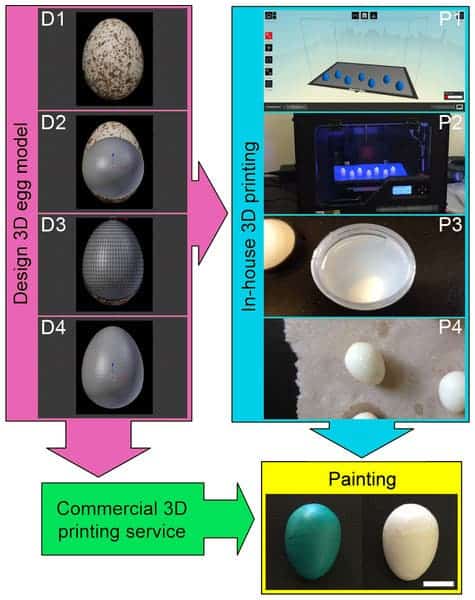It’s more than just a nasty trick – scientists have actually 3D printed eggs to help them better understand bird behaviour. They were especially interested in bird perception and what particular characteristics make them identify real eggs from fake ones.

You can add “fooling birds” to the long list of things that 3D printing can do. Animal behaviorist Mark Hauber of CUNY Hunter College worked with Blender Foundation’s open-source 3D graphics software and based their egg model design on a photograph. The eggs were then printed with four internal shell layers built on top of each other, using 0.3 and 0.2 mm layer thicknesses, and 0% infill. They then used a syringe to fill them with water and sealed them off.
Faking eggs is actually more common than you might think. Since the 1960s, biologists have made fake eggs for studies of bird behaviour, but 3D printing allows them to take it to a whole new level.
“Instead of using natural eggs, it’s best to use fake eggs, because you can control the size, and shape and the color much more accurately.”
Hauber remembers his first fake egg.
“In 1997, I went into a craft store and bought a beige speckled egg, which looks very much like a cowbird egg,” he says, recalling that it was actually an Easter decoration. He put it in the nest of a gray catbird, which promptly tossed it out.
The problem is that usually, the perfect fake egg can’t be found in a store, which is why they had to rely to 3D printing.
This particular study was aimed at cowbirds, brood parasitic species – they don’t care for their eggs, they simply dump them in he nests of other species. Sometimes the eggs get accepted, but sometimes they get rejected, and researchers wanted to see what makes the difference.
“It could be the size, it could be speckling itself or the lack thereof, and it could be the color — beige versus robin blue,” Hauber explains.

ANA LOPEZ/COURTESY OF MARK HAUBER
Usually, cowbirds manage to fool robins enough for the behaviour to make evolutionary sense, but they have to make the eggs as similar as possible to those of robbins. When it comes to behavioral studies, using fake eggs is better because you can manipulate their characteristics as you please.
They report that the 3D printed eggs stood up pretty well against the real thing – robins accepted them more often than not. Even when the fake eggs were painted blue as a test, robins accepted all the eggs. When they were painted white, they accepted only 21 percent of them – something which is coherent with previous plaster eggs studies. In case you didn’t know, robin eggs are deep blue – and it seems color plays a key role in identifying their eggs.
Christie Riehl, a biologist at Princeton University, was impressed by this study because it used a whole range of fake cowbird eggs — from small round ones to long skinny ones.
“You can imagine, it would be really labor-intensive and time-intensive to individually handcraft eggs that exploit that whole range of variation,” Riehl says, “and it would be very difficult to find commercially available eggs — like even wooden eggs or something — that would have the properties of size and shape that you’re trying to test.”
But an even more refined egg could have even more potential for this kind of research. All in all, Hauber and his colleagues seem to have opened a new door in terms of animal behaviour studies.
Journal Reference: (2015) Using 3D printed eggs to examine the egg-rejection behaviour of wild birds. PeerJ 3:e965https://dx.doi.org/10.7717/peerj.965






